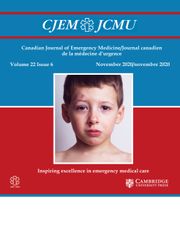Article contents
Prospective evaluation of a guideline for the selective elimination of pre-reduction radiographs in clinically obvious anterior shoulder dislocation
Published online by Cambridge University Press: 21 May 2015
Abstract:
Research has demonstrated that experienced emergency physicians can identify a subgroup of patients with shoulder dislocation for whom pre-reduction radiographs do not alter patient management. Based on that research, a treatment guideline for the selective elimination of pre-reduction radiographs in clinically evident cases of anterior shoulder dislocation was developed and implemented. The primary objective of this study was to prospectively determine whether the treatment guideline safely eliminates unnecessary radiographs.
We enrolled a convenience sample of patients who presented to our rural emergency department with possible shoulder dislocation between November 2000 and April 2001. Physicians scored their level of clinical diagnostic certainty on a 10-cm visual analogue scale prior to viewing pre-reduction radiographs (if obtained). Data were collected on clinical scoring and evaluation, compliance with the guideline, and outcomes.
A total of 63 patients were enrolled, ranging in age from 17 to 79 years (mean = 33); 87.3% were male. Emergency physicians were certain of shoulder dislocation in 59 (93.7%) patients (95% CI, 84.5%–98.2%) and complied with the treatment guideline in 52 patients (82.5%). Most deviations from the treatment guideline involved the elimination of post-reduction radiographs (which the guideline recommends for all patients). The treatment guideline eliminated 56 (88.9%, 95% CI, 78.4%–95.4%) pre-reduction radiographs, as compared to the standard practice of obtaining pre-reduction films for all cases of suspected shoulder dislocation (p < 0.0001)
Experienced emergency physicians are frequently certain of the diagnosis of anterior shoulder dislocation on clinical grounds alone and can comfortably and safely use this guideline for the selective elimination of pre-reduction radiographs. Compliance with the guideline substantially decreases pre-reduction radiographs. Validation of the guideline in other settings is warranted.
- Type
- EM Advances • Innovations en MU
- Information
- Copyright
- Copyright © Canadian Association of Emergency Physicians 2002
References
- 23
- Cited by


